Requirement for Recognition of Provision
VerifiedAdded on 2022/09/13
|10
|3277
|13
AI Summary
Contribute Materials
Your contribution can guide someone’s learning journey. Share your
documents today.
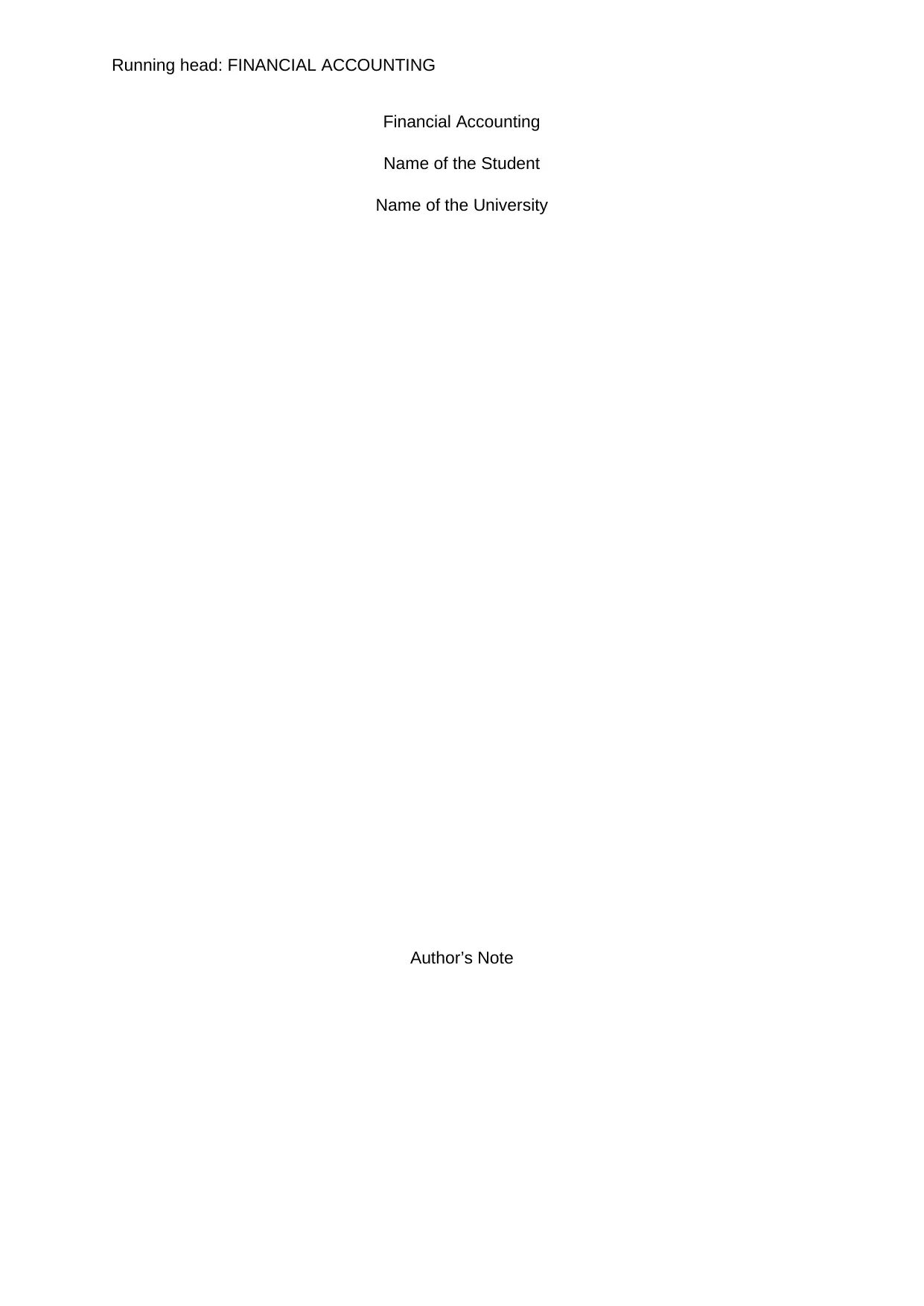
Running head: FINANCIAL ACCOUNTING
Financial Accounting
Name of the Student
Name of the University
Author’s Note
Financial Accounting
Name of the Student
Name of the University
Author’s Note
Secure Best Marks with AI Grader
Need help grading? Try our AI Grader for instant feedback on your assignments.
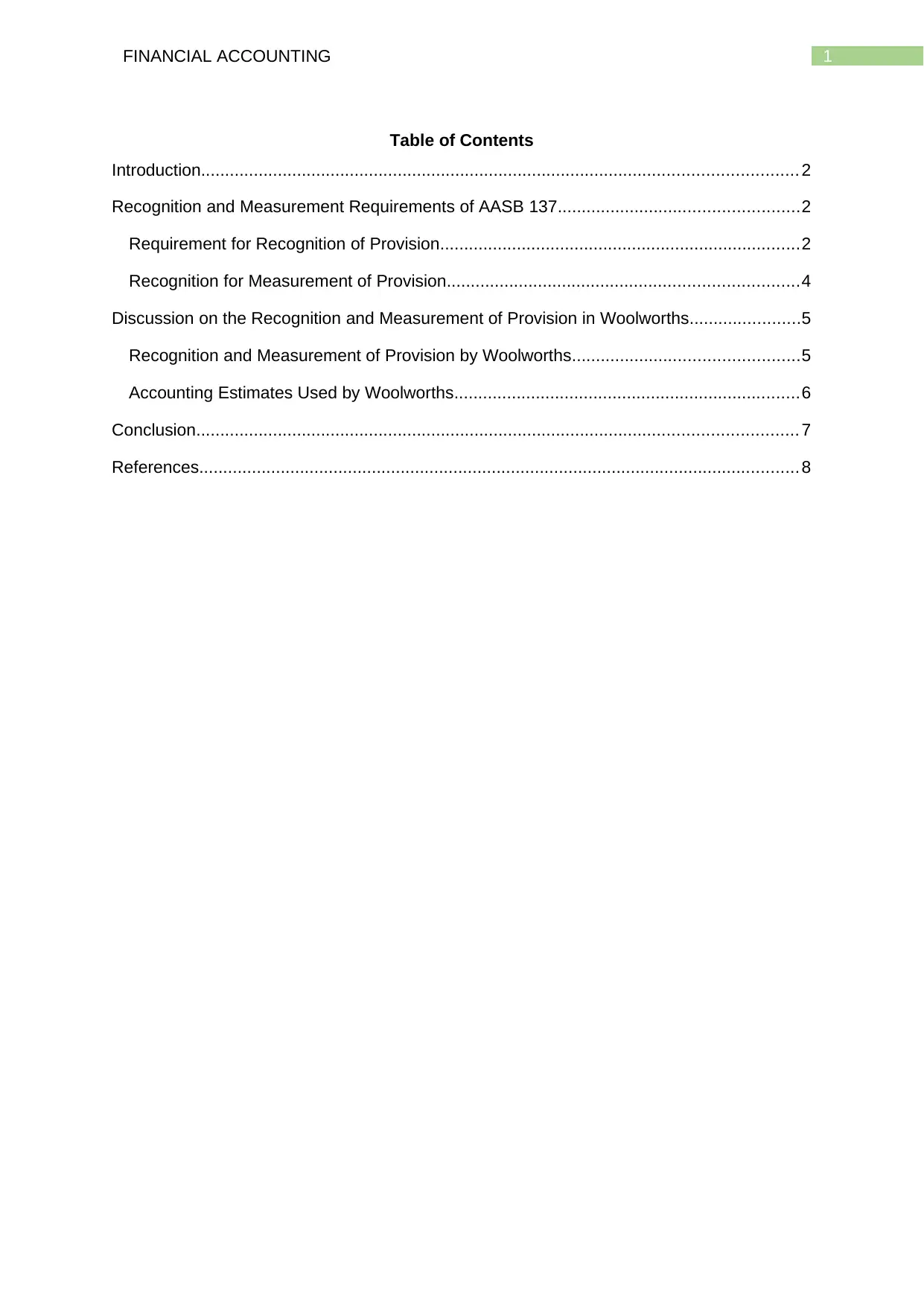
1FINANCIAL ACCOUNTING
Table of Contents
Introduction............................................................................................................................ 2
Recognition and Measurement Requirements of AASB 137..................................................2
Requirement for Recognition of Provision...........................................................................2
Recognition for Measurement of Provision.........................................................................4
Discussion on the Recognition and Measurement of Provision in Woolworths.......................5
Recognition and Measurement of Provision by Woolworths...............................................5
Accounting Estimates Used by Woolworths........................................................................6
Conclusion............................................................................................................................. 7
References............................................................................................................................. 8
Table of Contents
Introduction............................................................................................................................ 2
Recognition and Measurement Requirements of AASB 137..................................................2
Requirement for Recognition of Provision...........................................................................2
Recognition for Measurement of Provision.........................................................................4
Discussion on the Recognition and Measurement of Provision in Woolworths.......................5
Recognition and Measurement of Provision by Woolworths...............................................5
Accounting Estimates Used by Woolworths........................................................................6
Conclusion............................................................................................................................. 7
References............................................................................................................................. 8
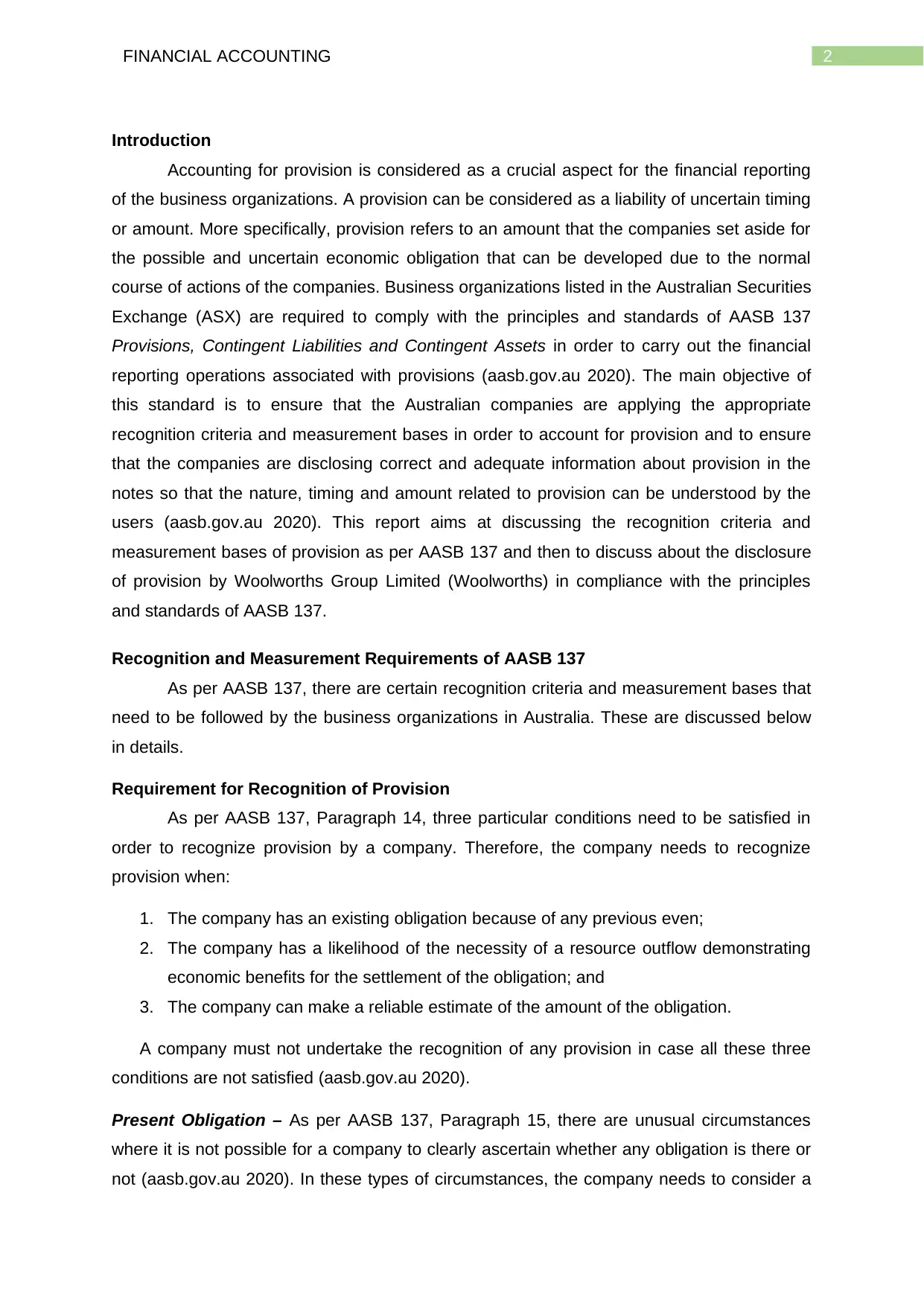
2FINANCIAL ACCOUNTING
Introduction
Accounting for provision is considered as a crucial aspect for the financial reporting
of the business organizations. A provision can be considered as a liability of uncertain timing
or amount. More specifically, provision refers to an amount that the companies set aside for
the possible and uncertain economic obligation that can be developed due to the normal
course of actions of the companies. Business organizations listed in the Australian Securities
Exchange (ASX) are required to comply with the principles and standards of AASB 137
Provisions, Contingent Liabilities and Contingent Assets in order to carry out the financial
reporting operations associated with provisions (aasb.gov.au 2020). The main objective of
this standard is to ensure that the Australian companies are applying the appropriate
recognition criteria and measurement bases in order to account for provision and to ensure
that the companies are disclosing correct and adequate information about provision in the
notes so that the nature, timing and amount related to provision can be understood by the
users (aasb.gov.au 2020). This report aims at discussing the recognition criteria and
measurement bases of provision as per AASB 137 and then to discuss about the disclosure
of provision by Woolworths Group Limited (Woolworths) in compliance with the principles
and standards of AASB 137.
Recognition and Measurement Requirements of AASB 137
As per AASB 137, there are certain recognition criteria and measurement bases that
need to be followed by the business organizations in Australia. These are discussed below
in details.
Requirement for Recognition of Provision
As per AASB 137, Paragraph 14, three particular conditions need to be satisfied in
order to recognize provision by a company. Therefore, the company needs to recognize
provision when:
1. The company has an existing obligation because of any previous even;
2. The company has a likelihood of the necessity of a resource outflow demonstrating
economic benefits for the settlement of the obligation; and
3. The company can make a reliable estimate of the amount of the obligation.
A company must not undertake the recognition of any provision in case all these three
conditions are not satisfied (aasb.gov.au 2020).
Present Obligation – As per AASB 137, Paragraph 15, there are unusual circumstances
where it is not possible for a company to clearly ascertain whether any obligation is there or
not (aasb.gov.au 2020). In these types of circumstances, the company needs to consider a
Introduction
Accounting for provision is considered as a crucial aspect for the financial reporting
of the business organizations. A provision can be considered as a liability of uncertain timing
or amount. More specifically, provision refers to an amount that the companies set aside for
the possible and uncertain economic obligation that can be developed due to the normal
course of actions of the companies. Business organizations listed in the Australian Securities
Exchange (ASX) are required to comply with the principles and standards of AASB 137
Provisions, Contingent Liabilities and Contingent Assets in order to carry out the financial
reporting operations associated with provisions (aasb.gov.au 2020). The main objective of
this standard is to ensure that the Australian companies are applying the appropriate
recognition criteria and measurement bases in order to account for provision and to ensure
that the companies are disclosing correct and adequate information about provision in the
notes so that the nature, timing and amount related to provision can be understood by the
users (aasb.gov.au 2020). This report aims at discussing the recognition criteria and
measurement bases of provision as per AASB 137 and then to discuss about the disclosure
of provision by Woolworths Group Limited (Woolworths) in compliance with the principles
and standards of AASB 137.
Recognition and Measurement Requirements of AASB 137
As per AASB 137, there are certain recognition criteria and measurement bases that
need to be followed by the business organizations in Australia. These are discussed below
in details.
Requirement for Recognition of Provision
As per AASB 137, Paragraph 14, three particular conditions need to be satisfied in
order to recognize provision by a company. Therefore, the company needs to recognize
provision when:
1. The company has an existing obligation because of any previous even;
2. The company has a likelihood of the necessity of a resource outflow demonstrating
economic benefits for the settlement of the obligation; and
3. The company can make a reliable estimate of the amount of the obligation.
A company must not undertake the recognition of any provision in case all these three
conditions are not satisfied (aasb.gov.au 2020).
Present Obligation – As per AASB 137, Paragraph 15, there are unusual circumstances
where it is not possible for a company to clearly ascertain whether any obligation is there or
not (aasb.gov.au 2020). In these types of circumstances, the company needs to consider a
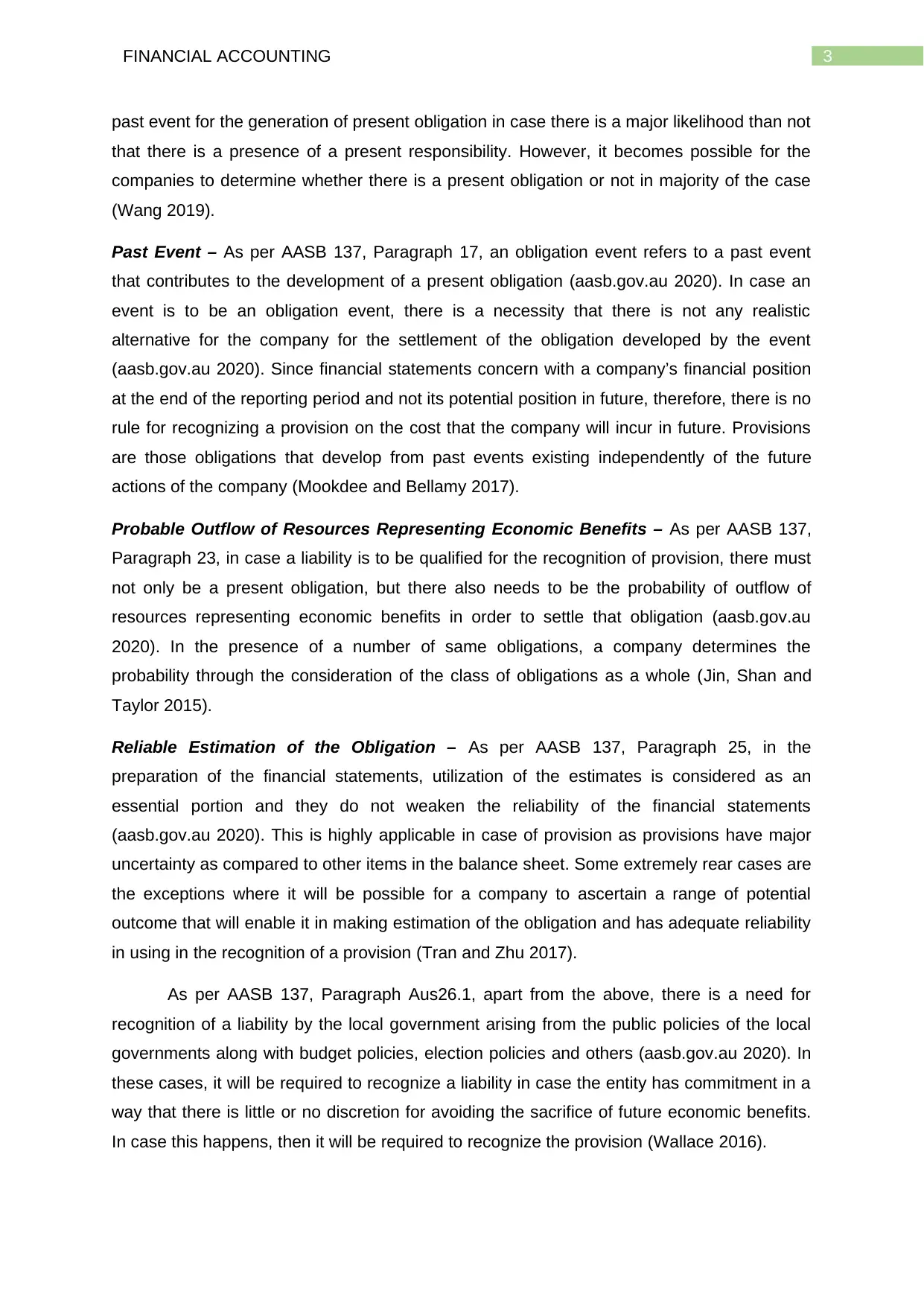
3FINANCIAL ACCOUNTING
past event for the generation of present obligation in case there is a major likelihood than not
that there is a presence of a present responsibility. However, it becomes possible for the
companies to determine whether there is a present obligation or not in majority of the case
(Wang 2019).
Past Event – As per AASB 137, Paragraph 17, an obligation event refers to a past event
that contributes to the development of a present obligation (aasb.gov.au 2020). In case an
event is to be an obligation event, there is a necessity that there is not any realistic
alternative for the company for the settlement of the obligation developed by the event
(aasb.gov.au 2020). Since financial statements concern with a company’s financial position
at the end of the reporting period and not its potential position in future, therefore, there is no
rule for recognizing a provision on the cost that the company will incur in future. Provisions
are those obligations that develop from past events existing independently of the future
actions of the company (Mookdee and Bellamy 2017).
Probable Outflow of Resources Representing Economic Benefits – As per AASB 137,
Paragraph 23, in case a liability is to be qualified for the recognition of provision, there must
not only be a present obligation, but there also needs to be the probability of outflow of
resources representing economic benefits in order to settle that obligation (aasb.gov.au
2020). In the presence of a number of same obligations, a company determines the
probability through the consideration of the class of obligations as a whole (Jin, Shan and
Taylor 2015).
Reliable Estimation of the Obligation – As per AASB 137, Paragraph 25, in the
preparation of the financial statements, utilization of the estimates is considered as an
essential portion and they do not weaken the reliability of the financial statements
(aasb.gov.au 2020). This is highly applicable in case of provision as provisions have major
uncertainty as compared to other items in the balance sheet. Some extremely rear cases are
the exceptions where it will be possible for a company to ascertain a range of potential
outcome that will enable it in making estimation of the obligation and has adequate reliability
in using in the recognition of a provision (Tran and Zhu 2017).
As per AASB 137, Paragraph Aus26.1, apart from the above, there is a need for
recognition of a liability by the local government arising from the public policies of the local
governments along with budget policies, election policies and others (aasb.gov.au 2020). In
these cases, it will be required to recognize a liability in case the entity has commitment in a
way that there is little or no discretion for avoiding the sacrifice of future economic benefits.
In case this happens, then it will be required to recognize the provision (Wallace 2016).
past event for the generation of present obligation in case there is a major likelihood than not
that there is a presence of a present responsibility. However, it becomes possible for the
companies to determine whether there is a present obligation or not in majority of the case
(Wang 2019).
Past Event – As per AASB 137, Paragraph 17, an obligation event refers to a past event
that contributes to the development of a present obligation (aasb.gov.au 2020). In case an
event is to be an obligation event, there is a necessity that there is not any realistic
alternative for the company for the settlement of the obligation developed by the event
(aasb.gov.au 2020). Since financial statements concern with a company’s financial position
at the end of the reporting period and not its potential position in future, therefore, there is no
rule for recognizing a provision on the cost that the company will incur in future. Provisions
are those obligations that develop from past events existing independently of the future
actions of the company (Mookdee and Bellamy 2017).
Probable Outflow of Resources Representing Economic Benefits – As per AASB 137,
Paragraph 23, in case a liability is to be qualified for the recognition of provision, there must
not only be a present obligation, but there also needs to be the probability of outflow of
resources representing economic benefits in order to settle that obligation (aasb.gov.au
2020). In the presence of a number of same obligations, a company determines the
probability through the consideration of the class of obligations as a whole (Jin, Shan and
Taylor 2015).
Reliable Estimation of the Obligation – As per AASB 137, Paragraph 25, in the
preparation of the financial statements, utilization of the estimates is considered as an
essential portion and they do not weaken the reliability of the financial statements
(aasb.gov.au 2020). This is highly applicable in case of provision as provisions have major
uncertainty as compared to other items in the balance sheet. Some extremely rear cases are
the exceptions where it will be possible for a company to ascertain a range of potential
outcome that will enable it in making estimation of the obligation and has adequate reliability
in using in the recognition of a provision (Tran and Zhu 2017).
As per AASB 137, Paragraph Aus26.1, apart from the above, there is a need for
recognition of a liability by the local government arising from the public policies of the local
governments along with budget policies, election policies and others (aasb.gov.au 2020). In
these cases, it will be required to recognize a liability in case the entity has commitment in a
way that there is little or no discretion for avoiding the sacrifice of future economic benefits.
In case this happens, then it will be required to recognize the provision (Wallace 2016).
Secure Best Marks with AI Grader
Need help grading? Try our AI Grader for instant feedback on your assignments.
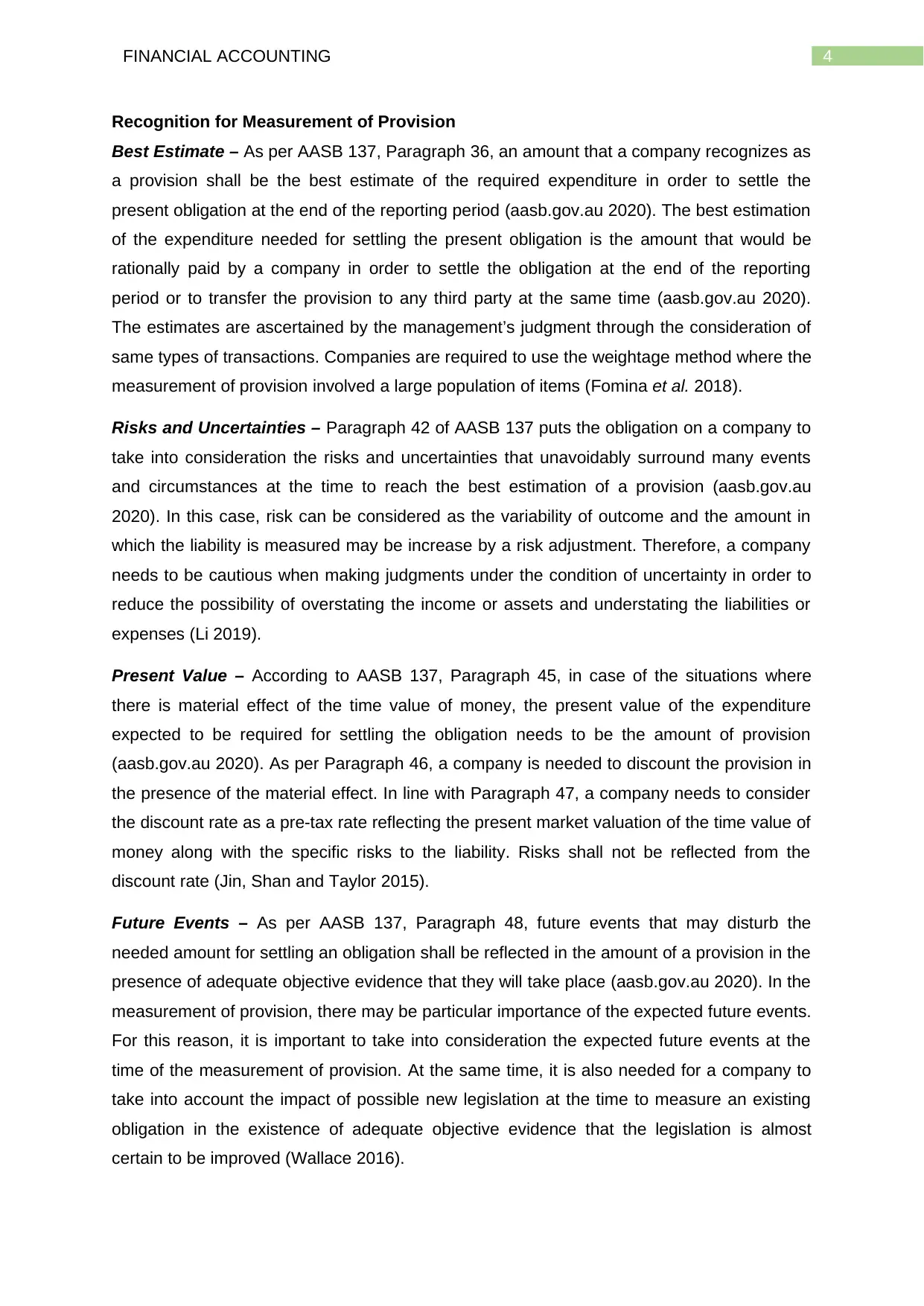
4FINANCIAL ACCOUNTING
Recognition for Measurement of Provision
Best Estimate – As per AASB 137, Paragraph 36, an amount that a company recognizes as
a provision shall be the best estimate of the required expenditure in order to settle the
present obligation at the end of the reporting period (aasb.gov.au 2020). The best estimation
of the expenditure needed for settling the present obligation is the amount that would be
rationally paid by a company in order to settle the obligation at the end of the reporting
period or to transfer the provision to any third party at the same time (aasb.gov.au 2020).
The estimates are ascertained by the management’s judgment through the consideration of
same types of transactions. Companies are required to use the weightage method where the
measurement of provision involved a large population of items (Fomina et al. 2018).
Risks and Uncertainties – Paragraph 42 of AASB 137 puts the obligation on a company to
take into consideration the risks and uncertainties that unavoidably surround many events
and circumstances at the time to reach the best estimation of a provision (aasb.gov.au
2020). In this case, risk can be considered as the variability of outcome and the amount in
which the liability is measured may be increase by a risk adjustment. Therefore, a company
needs to be cautious when making judgments under the condition of uncertainty in order to
reduce the possibility of overstating the income or assets and understating the liabilities or
expenses (Li 2019).
Present Value – According to AASB 137, Paragraph 45, in case of the situations where
there is material effect of the time value of money, the present value of the expenditure
expected to be required for settling the obligation needs to be the amount of provision
(aasb.gov.au 2020). As per Paragraph 46, a company is needed to discount the provision in
the presence of the material effect. In line with Paragraph 47, a company needs to consider
the discount rate as a pre-tax rate reflecting the present market valuation of the time value of
money along with the specific risks to the liability. Risks shall not be reflected from the
discount rate (Jin, Shan and Taylor 2015).
Future Events – As per AASB 137, Paragraph 48, future events that may disturb the
needed amount for settling an obligation shall be reflected in the amount of a provision in the
presence of adequate objective evidence that they will take place (aasb.gov.au 2020). In the
measurement of provision, there may be particular importance of the expected future events.
For this reason, it is important to take into consideration the expected future events at the
time of the measurement of provision. At the same time, it is also needed for a company to
take into account the impact of possible new legislation at the time to measure an existing
obligation in the existence of adequate objective evidence that the legislation is almost
certain to be improved (Wallace 2016).
Recognition for Measurement of Provision
Best Estimate – As per AASB 137, Paragraph 36, an amount that a company recognizes as
a provision shall be the best estimate of the required expenditure in order to settle the
present obligation at the end of the reporting period (aasb.gov.au 2020). The best estimation
of the expenditure needed for settling the present obligation is the amount that would be
rationally paid by a company in order to settle the obligation at the end of the reporting
period or to transfer the provision to any third party at the same time (aasb.gov.au 2020).
The estimates are ascertained by the management’s judgment through the consideration of
same types of transactions. Companies are required to use the weightage method where the
measurement of provision involved a large population of items (Fomina et al. 2018).
Risks and Uncertainties – Paragraph 42 of AASB 137 puts the obligation on a company to
take into consideration the risks and uncertainties that unavoidably surround many events
and circumstances at the time to reach the best estimation of a provision (aasb.gov.au
2020). In this case, risk can be considered as the variability of outcome and the amount in
which the liability is measured may be increase by a risk adjustment. Therefore, a company
needs to be cautious when making judgments under the condition of uncertainty in order to
reduce the possibility of overstating the income or assets and understating the liabilities or
expenses (Li 2019).
Present Value – According to AASB 137, Paragraph 45, in case of the situations where
there is material effect of the time value of money, the present value of the expenditure
expected to be required for settling the obligation needs to be the amount of provision
(aasb.gov.au 2020). As per Paragraph 46, a company is needed to discount the provision in
the presence of the material effect. In line with Paragraph 47, a company needs to consider
the discount rate as a pre-tax rate reflecting the present market valuation of the time value of
money along with the specific risks to the liability. Risks shall not be reflected from the
discount rate (Jin, Shan and Taylor 2015).
Future Events – As per AASB 137, Paragraph 48, future events that may disturb the
needed amount for settling an obligation shall be reflected in the amount of a provision in the
presence of adequate objective evidence that they will take place (aasb.gov.au 2020). In the
measurement of provision, there may be particular importance of the expected future events.
For this reason, it is important to take into consideration the expected future events at the
time of the measurement of provision. At the same time, it is also needed for a company to
take into account the impact of possible new legislation at the time to measure an existing
obligation in the existence of adequate objective evidence that the legislation is almost
certain to be improved (Wallace 2016).
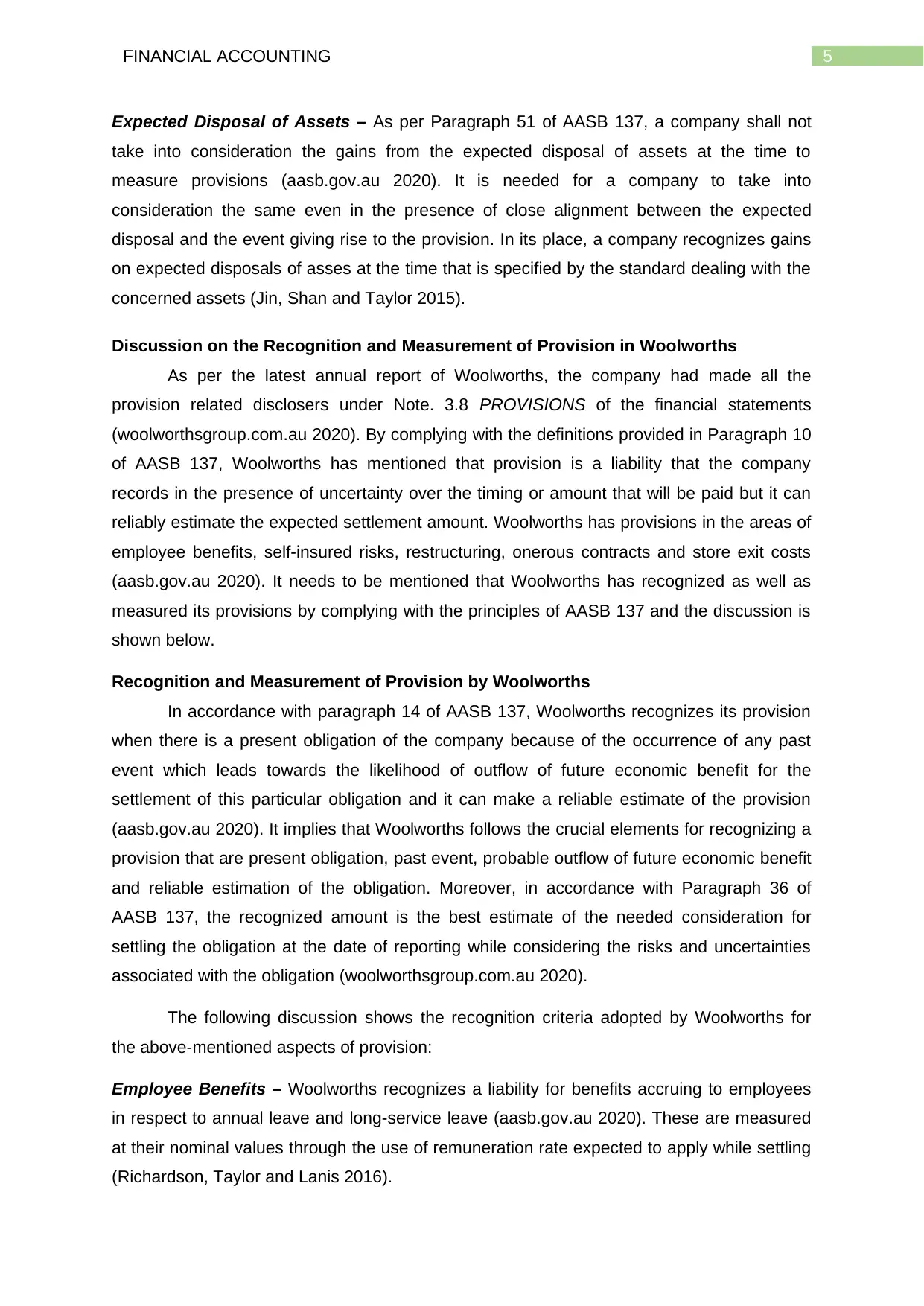
5FINANCIAL ACCOUNTING
Expected Disposal of Assets – As per Paragraph 51 of AASB 137, a company shall not
take into consideration the gains from the expected disposal of assets at the time to
measure provisions (aasb.gov.au 2020). It is needed for a company to take into
consideration the same even in the presence of close alignment between the expected
disposal and the event giving rise to the provision. In its place, a company recognizes gains
on expected disposals of asses at the time that is specified by the standard dealing with the
concerned assets (Jin, Shan and Taylor 2015).
Discussion on the Recognition and Measurement of Provision in Woolworths
As per the latest annual report of Woolworths, the company had made all the
provision related disclosers under Note. 3.8 PROVISIONS of the financial statements
(woolworthsgroup.com.au 2020). By complying with the definitions provided in Paragraph 10
of AASB 137, Woolworths has mentioned that provision is a liability that the company
records in the presence of uncertainty over the timing or amount that will be paid but it can
reliably estimate the expected settlement amount. Woolworths has provisions in the areas of
employee benefits, self-insured risks, restructuring, onerous contracts and store exit costs
(aasb.gov.au 2020). It needs to be mentioned that Woolworths has recognized as well as
measured its provisions by complying with the principles of AASB 137 and the discussion is
shown below.
Recognition and Measurement of Provision by Woolworths
In accordance with paragraph 14 of AASB 137, Woolworths recognizes its provision
when there is a present obligation of the company because of the occurrence of any past
event which leads towards the likelihood of outflow of future economic benefit for the
settlement of this particular obligation and it can make a reliable estimate of the provision
(aasb.gov.au 2020). It implies that Woolworths follows the crucial elements for recognizing a
provision that are present obligation, past event, probable outflow of future economic benefit
and reliable estimation of the obligation. Moreover, in accordance with Paragraph 36 of
AASB 137, the recognized amount is the best estimate of the needed consideration for
settling the obligation at the date of reporting while considering the risks and uncertainties
associated with the obligation (woolworthsgroup.com.au 2020).
The following discussion shows the recognition criteria adopted by Woolworths for
the above-mentioned aspects of provision:
Employee Benefits – Woolworths recognizes a liability for benefits accruing to employees
in respect to annual leave and long-service leave (aasb.gov.au 2020). These are measured
at their nominal values through the use of remuneration rate expected to apply while settling
(Richardson, Taylor and Lanis 2016).
Expected Disposal of Assets – As per Paragraph 51 of AASB 137, a company shall not
take into consideration the gains from the expected disposal of assets at the time to
measure provisions (aasb.gov.au 2020). It is needed for a company to take into
consideration the same even in the presence of close alignment between the expected
disposal and the event giving rise to the provision. In its place, a company recognizes gains
on expected disposals of asses at the time that is specified by the standard dealing with the
concerned assets (Jin, Shan and Taylor 2015).
Discussion on the Recognition and Measurement of Provision in Woolworths
As per the latest annual report of Woolworths, the company had made all the
provision related disclosers under Note. 3.8 PROVISIONS of the financial statements
(woolworthsgroup.com.au 2020). By complying with the definitions provided in Paragraph 10
of AASB 137, Woolworths has mentioned that provision is a liability that the company
records in the presence of uncertainty over the timing or amount that will be paid but it can
reliably estimate the expected settlement amount. Woolworths has provisions in the areas of
employee benefits, self-insured risks, restructuring, onerous contracts and store exit costs
(aasb.gov.au 2020). It needs to be mentioned that Woolworths has recognized as well as
measured its provisions by complying with the principles of AASB 137 and the discussion is
shown below.
Recognition and Measurement of Provision by Woolworths
In accordance with paragraph 14 of AASB 137, Woolworths recognizes its provision
when there is a present obligation of the company because of the occurrence of any past
event which leads towards the likelihood of outflow of future economic benefit for the
settlement of this particular obligation and it can make a reliable estimate of the provision
(aasb.gov.au 2020). It implies that Woolworths follows the crucial elements for recognizing a
provision that are present obligation, past event, probable outflow of future economic benefit
and reliable estimation of the obligation. Moreover, in accordance with Paragraph 36 of
AASB 137, the recognized amount is the best estimate of the needed consideration for
settling the obligation at the date of reporting while considering the risks and uncertainties
associated with the obligation (woolworthsgroup.com.au 2020).
The following discussion shows the recognition criteria adopted by Woolworths for
the above-mentioned aspects of provision:
Employee Benefits – Woolworths recognizes a liability for benefits accruing to employees
in respect to annual leave and long-service leave (aasb.gov.au 2020). These are measured
at their nominal values through the use of remuneration rate expected to apply while settling
(Richardson, Taylor and Lanis 2016).
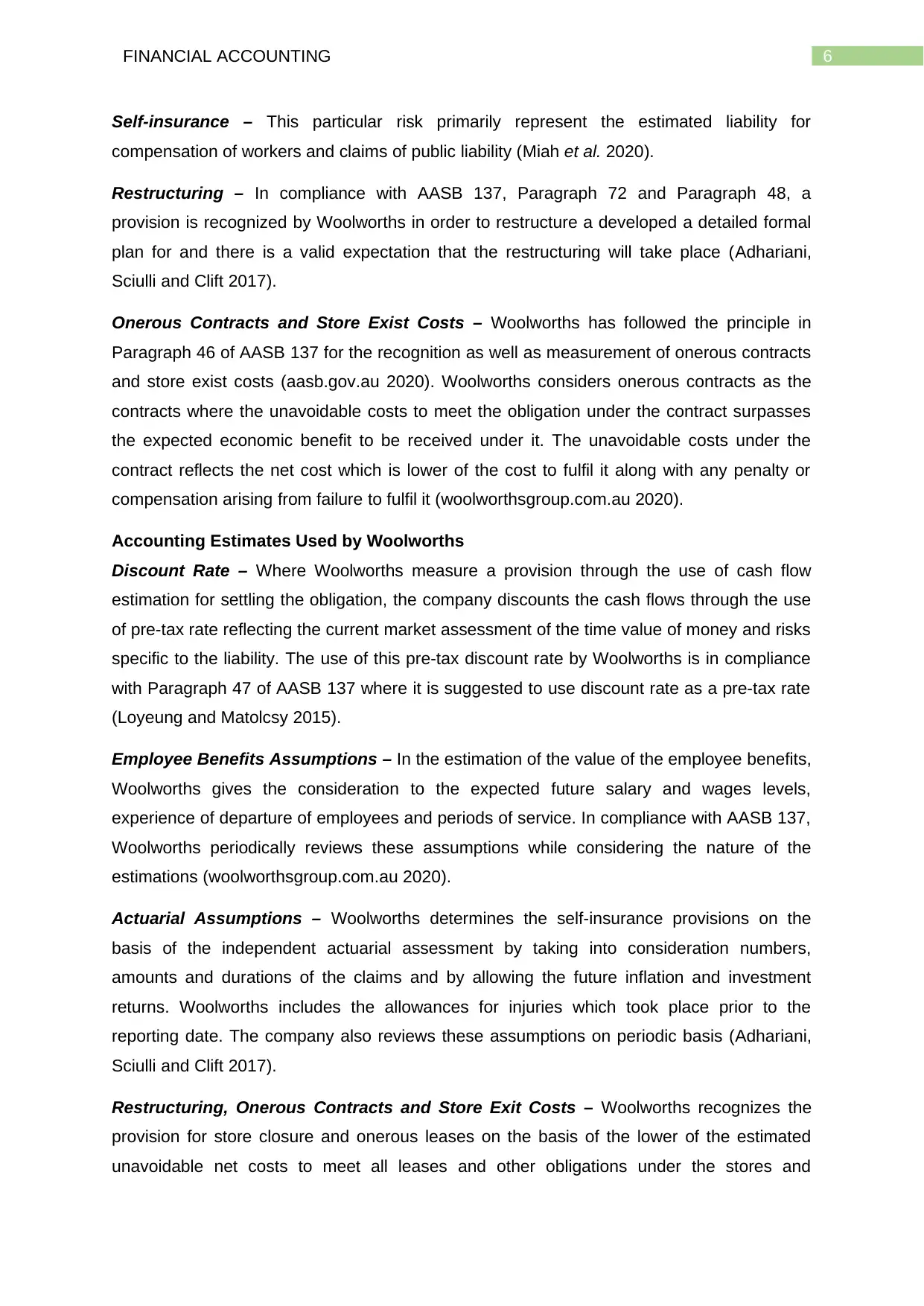
6FINANCIAL ACCOUNTING
Self-insurance – This particular risk primarily represent the estimated liability for
compensation of workers and claims of public liability (Miah et al. 2020).
Restructuring – In compliance with AASB 137, Paragraph 72 and Paragraph 48, a
provision is recognized by Woolworths in order to restructure a developed a detailed formal
plan for and there is a valid expectation that the restructuring will take place (Adhariani,
Sciulli and Clift 2017).
Onerous Contracts and Store Exist Costs – Woolworths has followed the principle in
Paragraph 46 of AASB 137 for the recognition as well as measurement of onerous contracts
and store exist costs (aasb.gov.au 2020). Woolworths considers onerous contracts as the
contracts where the unavoidable costs to meet the obligation under the contract surpasses
the expected economic benefit to be received under it. The unavoidable costs under the
contract reflects the net cost which is lower of the cost to fulfil it along with any penalty or
compensation arising from failure to fulfil it (woolworthsgroup.com.au 2020).
Accounting Estimates Used by Woolworths
Discount Rate – Where Woolworths measure a provision through the use of cash flow
estimation for settling the obligation, the company discounts the cash flows through the use
of pre-tax rate reflecting the current market assessment of the time value of money and risks
specific to the liability. The use of this pre-tax discount rate by Woolworths is in compliance
with Paragraph 47 of AASB 137 where it is suggested to use discount rate as a pre-tax rate
(Loyeung and Matolcsy 2015).
Employee Benefits Assumptions – In the estimation of the value of the employee benefits,
Woolworths gives the consideration to the expected future salary and wages levels,
experience of departure of employees and periods of service. In compliance with AASB 137,
Woolworths periodically reviews these assumptions while considering the nature of the
estimations (woolworthsgroup.com.au 2020).
Actuarial Assumptions – Woolworths determines the self-insurance provisions on the
basis of the independent actuarial assessment by taking into consideration numbers,
amounts and durations of the claims and by allowing the future inflation and investment
returns. Woolworths includes the allowances for injuries which took place prior to the
reporting date. The company also reviews these assumptions on periodic basis (Adhariani,
Sciulli and Clift 2017).
Restructuring, Onerous Contracts and Store Exit Costs – Woolworths recognizes the
provision for store closure and onerous leases on the basis of the lower of the estimated
unavoidable net costs to meet all leases and other obligations under the stores and
Self-insurance – This particular risk primarily represent the estimated liability for
compensation of workers and claims of public liability (Miah et al. 2020).
Restructuring – In compliance with AASB 137, Paragraph 72 and Paragraph 48, a
provision is recognized by Woolworths in order to restructure a developed a detailed formal
plan for and there is a valid expectation that the restructuring will take place (Adhariani,
Sciulli and Clift 2017).
Onerous Contracts and Store Exist Costs – Woolworths has followed the principle in
Paragraph 46 of AASB 137 for the recognition as well as measurement of onerous contracts
and store exist costs (aasb.gov.au 2020). Woolworths considers onerous contracts as the
contracts where the unavoidable costs to meet the obligation under the contract surpasses
the expected economic benefit to be received under it. The unavoidable costs under the
contract reflects the net cost which is lower of the cost to fulfil it along with any penalty or
compensation arising from failure to fulfil it (woolworthsgroup.com.au 2020).
Accounting Estimates Used by Woolworths
Discount Rate – Where Woolworths measure a provision through the use of cash flow
estimation for settling the obligation, the company discounts the cash flows through the use
of pre-tax rate reflecting the current market assessment of the time value of money and risks
specific to the liability. The use of this pre-tax discount rate by Woolworths is in compliance
with Paragraph 47 of AASB 137 where it is suggested to use discount rate as a pre-tax rate
(Loyeung and Matolcsy 2015).
Employee Benefits Assumptions – In the estimation of the value of the employee benefits,
Woolworths gives the consideration to the expected future salary and wages levels,
experience of departure of employees and periods of service. In compliance with AASB 137,
Woolworths periodically reviews these assumptions while considering the nature of the
estimations (woolworthsgroup.com.au 2020).
Actuarial Assumptions – Woolworths determines the self-insurance provisions on the
basis of the independent actuarial assessment by taking into consideration numbers,
amounts and durations of the claims and by allowing the future inflation and investment
returns. Woolworths includes the allowances for injuries which took place prior to the
reporting date. The company also reviews these assumptions on periodic basis (Adhariani,
Sciulli and Clift 2017).
Restructuring, Onerous Contracts and Store Exit Costs – Woolworths recognizes the
provision for store closure and onerous leases on the basis of the lower of the estimated
unavoidable net costs to meet all leases and other obligations under the stores and
Paraphrase This Document
Need a fresh take? Get an instant paraphrase of this document with our AI Paraphraser
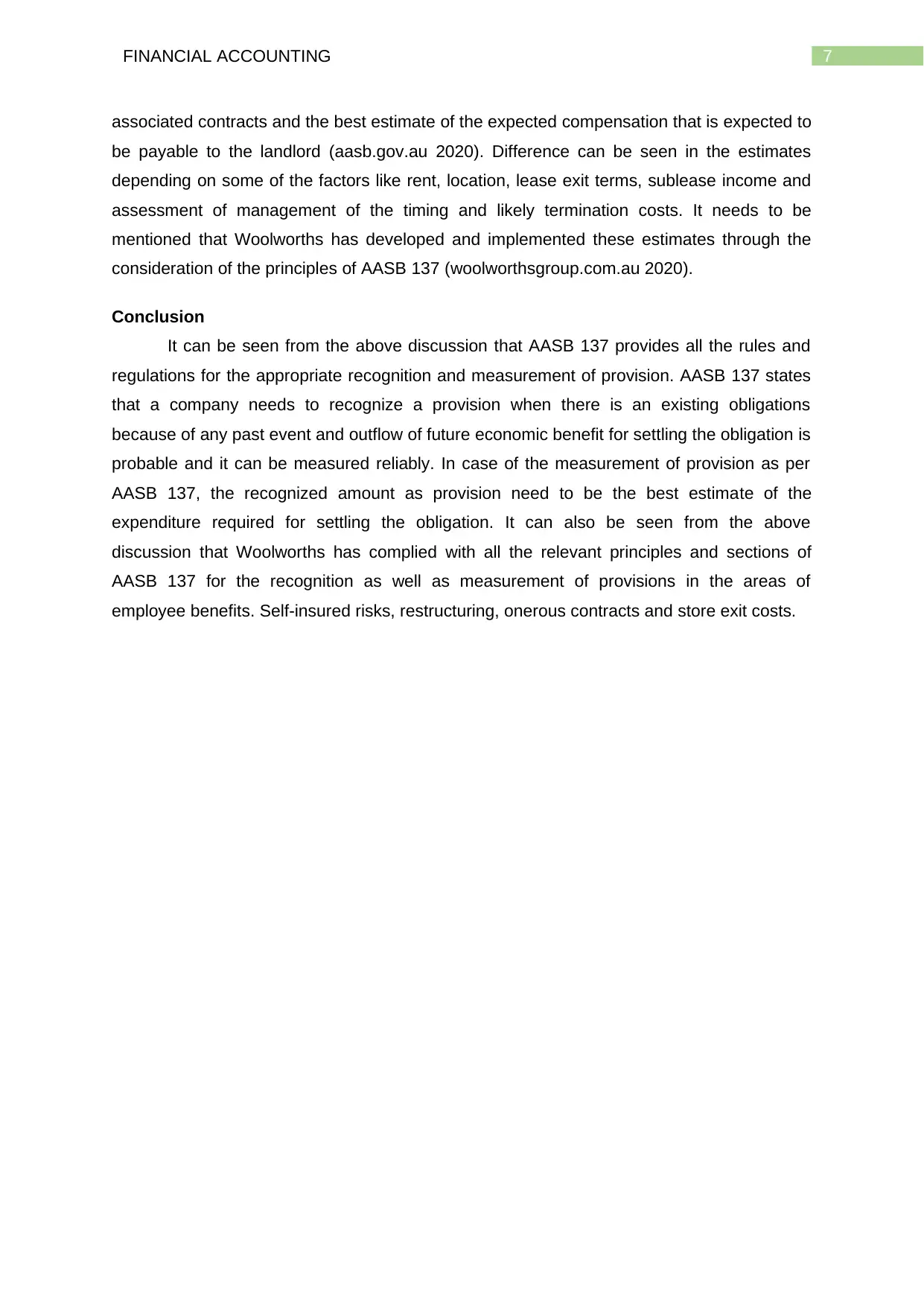
7FINANCIAL ACCOUNTING
associated contracts and the best estimate of the expected compensation that is expected to
be payable to the landlord (aasb.gov.au 2020). Difference can be seen in the estimates
depending on some of the factors like rent, location, lease exit terms, sublease income and
assessment of management of the timing and likely termination costs. It needs to be
mentioned that Woolworths has developed and implemented these estimates through the
consideration of the principles of AASB 137 (woolworthsgroup.com.au 2020).
Conclusion
It can be seen from the above discussion that AASB 137 provides all the rules and
regulations for the appropriate recognition and measurement of provision. AASB 137 states
that a company needs to recognize a provision when there is an existing obligations
because of any past event and outflow of future economic benefit for settling the obligation is
probable and it can be measured reliably. In case of the measurement of provision as per
AASB 137, the recognized amount as provision need to be the best estimate of the
expenditure required for settling the obligation. It can also be seen from the above
discussion that Woolworths has complied with all the relevant principles and sections of
AASB 137 for the recognition as well as measurement of provisions in the areas of
employee benefits. Self-insured risks, restructuring, onerous contracts and store exit costs.
associated contracts and the best estimate of the expected compensation that is expected to
be payable to the landlord (aasb.gov.au 2020). Difference can be seen in the estimates
depending on some of the factors like rent, location, lease exit terms, sublease income and
assessment of management of the timing and likely termination costs. It needs to be
mentioned that Woolworths has developed and implemented these estimates through the
consideration of the principles of AASB 137 (woolworthsgroup.com.au 2020).
Conclusion
It can be seen from the above discussion that AASB 137 provides all the rules and
regulations for the appropriate recognition and measurement of provision. AASB 137 states
that a company needs to recognize a provision when there is an existing obligations
because of any past event and outflow of future economic benefit for settling the obligation is
probable and it can be measured reliably. In case of the measurement of provision as per
AASB 137, the recognized amount as provision need to be the best estimate of the
expenditure required for settling the obligation. It can also be seen from the above
discussion that Woolworths has complied with all the relevant principles and sections of
AASB 137 for the recognition as well as measurement of provisions in the areas of
employee benefits. Self-insured risks, restructuring, onerous contracts and store exit costs.
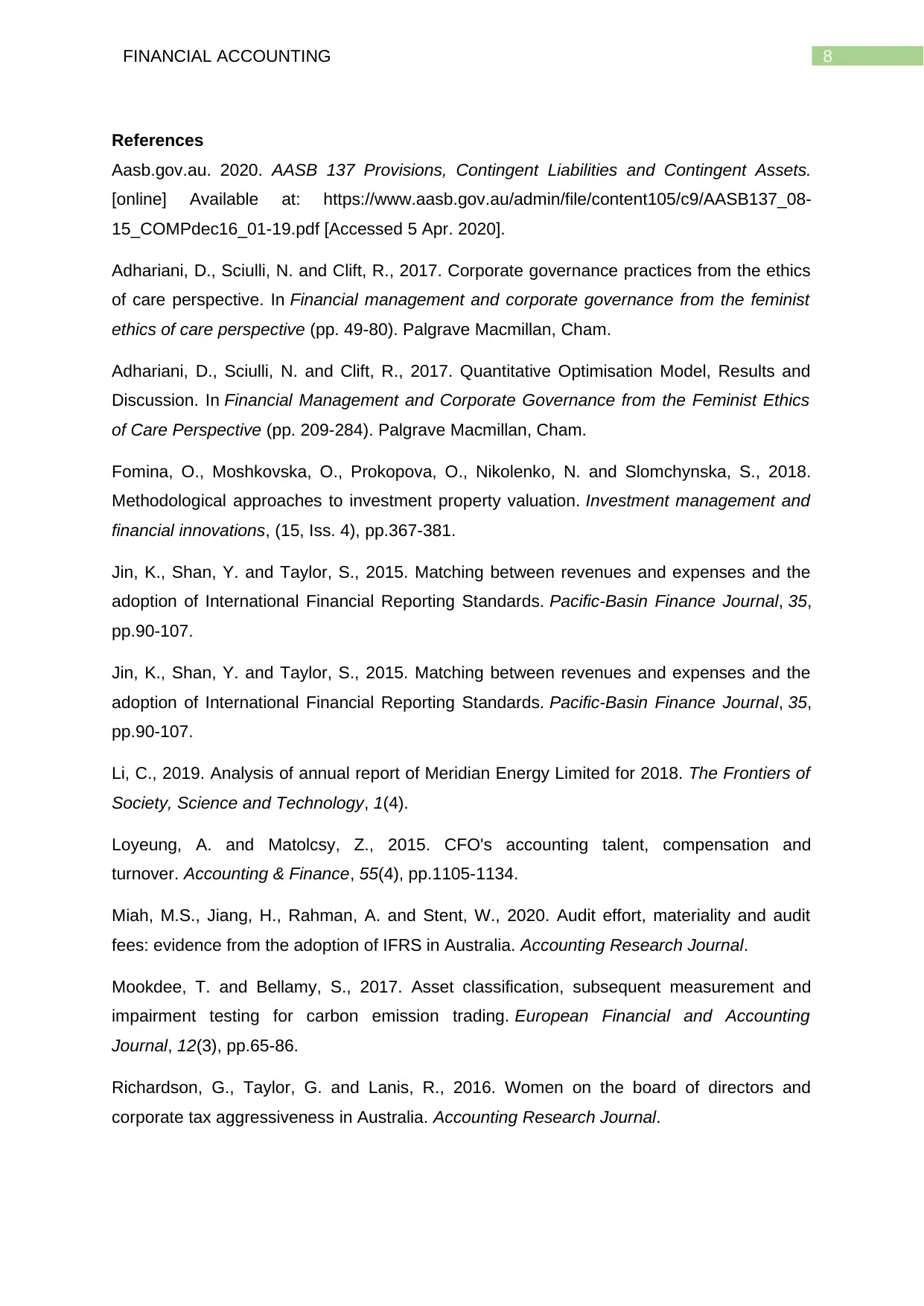
8FINANCIAL ACCOUNTING
References
Aasb.gov.au. 2020. AASB 137 Provisions, Contingent Liabilities and Contingent Assets.
[online] Available at: https://www.aasb.gov.au/admin/file/content105/c9/AASB137_08-
15_COMPdec16_01-19.pdf [Accessed 5 Apr. 2020].
Adhariani, D., Sciulli, N. and Clift, R., 2017. Corporate governance practices from the ethics
of care perspective. In Financial management and corporate governance from the feminist
ethics of care perspective (pp. 49-80). Palgrave Macmillan, Cham.
Adhariani, D., Sciulli, N. and Clift, R., 2017. Quantitative Optimisation Model, Results and
Discussion. In Financial Management and Corporate Governance from the Feminist Ethics
of Care Perspective (pp. 209-284). Palgrave Macmillan, Cham.
Fomina, O., Moshkovska, O., Prokopova, O., Nikolenko, N. and Slomchynska, S., 2018.
Methodological approaches to investment property valuation. Investment management and
financial innovations, (15, Iss. 4), pp.367-381.
Jin, K., Shan, Y. and Taylor, S., 2015. Matching between revenues and expenses and the
adoption of International Financial Reporting Standards. Pacific-Basin Finance Journal, 35,
pp.90-107.
Jin, K., Shan, Y. and Taylor, S., 2015. Matching between revenues and expenses and the
adoption of International Financial Reporting Standards. Pacific-Basin Finance Journal, 35,
pp.90-107.
Li, C., 2019. Analysis of annual report of Meridian Energy Limited for 2018. The Frontiers of
Society, Science and Technology, 1(4).
Loyeung, A. and Matolcsy, Z., 2015. CFO's accounting talent, compensation and
turnover. Accounting & Finance, 55(4), pp.1105-1134.
Miah, M.S., Jiang, H., Rahman, A. and Stent, W., 2020. Audit effort, materiality and audit
fees: evidence from the adoption of IFRS in Australia. Accounting Research Journal.
Mookdee, T. and Bellamy, S., 2017. Asset classification, subsequent measurement and
impairment testing for carbon emission trading. European Financial and Accounting
Journal, 12(3), pp.65-86.
Richardson, G., Taylor, G. and Lanis, R., 2016. Women on the board of directors and
corporate tax aggressiveness in Australia. Accounting Research Journal.
References
Aasb.gov.au. 2020. AASB 137 Provisions, Contingent Liabilities and Contingent Assets.
[online] Available at: https://www.aasb.gov.au/admin/file/content105/c9/AASB137_08-
15_COMPdec16_01-19.pdf [Accessed 5 Apr. 2020].
Adhariani, D., Sciulli, N. and Clift, R., 2017. Corporate governance practices from the ethics
of care perspective. In Financial management and corporate governance from the feminist
ethics of care perspective (pp. 49-80). Palgrave Macmillan, Cham.
Adhariani, D., Sciulli, N. and Clift, R., 2017. Quantitative Optimisation Model, Results and
Discussion. In Financial Management and Corporate Governance from the Feminist Ethics
of Care Perspective (pp. 209-284). Palgrave Macmillan, Cham.
Fomina, O., Moshkovska, O., Prokopova, O., Nikolenko, N. and Slomchynska, S., 2018.
Methodological approaches to investment property valuation. Investment management and
financial innovations, (15, Iss. 4), pp.367-381.
Jin, K., Shan, Y. and Taylor, S., 2015. Matching between revenues and expenses and the
adoption of International Financial Reporting Standards. Pacific-Basin Finance Journal, 35,
pp.90-107.
Jin, K., Shan, Y. and Taylor, S., 2015. Matching between revenues and expenses and the
adoption of International Financial Reporting Standards. Pacific-Basin Finance Journal, 35,
pp.90-107.
Li, C., 2019. Analysis of annual report of Meridian Energy Limited for 2018. The Frontiers of
Society, Science and Technology, 1(4).
Loyeung, A. and Matolcsy, Z., 2015. CFO's accounting talent, compensation and
turnover. Accounting & Finance, 55(4), pp.1105-1134.
Miah, M.S., Jiang, H., Rahman, A. and Stent, W., 2020. Audit effort, materiality and audit
fees: evidence from the adoption of IFRS in Australia. Accounting Research Journal.
Mookdee, T. and Bellamy, S., 2017. Asset classification, subsequent measurement and
impairment testing for carbon emission trading. European Financial and Accounting
Journal, 12(3), pp.65-86.
Richardson, G., Taylor, G. and Lanis, R., 2016. Women on the board of directors and
corporate tax aggressiveness in Australia. Accounting Research Journal.
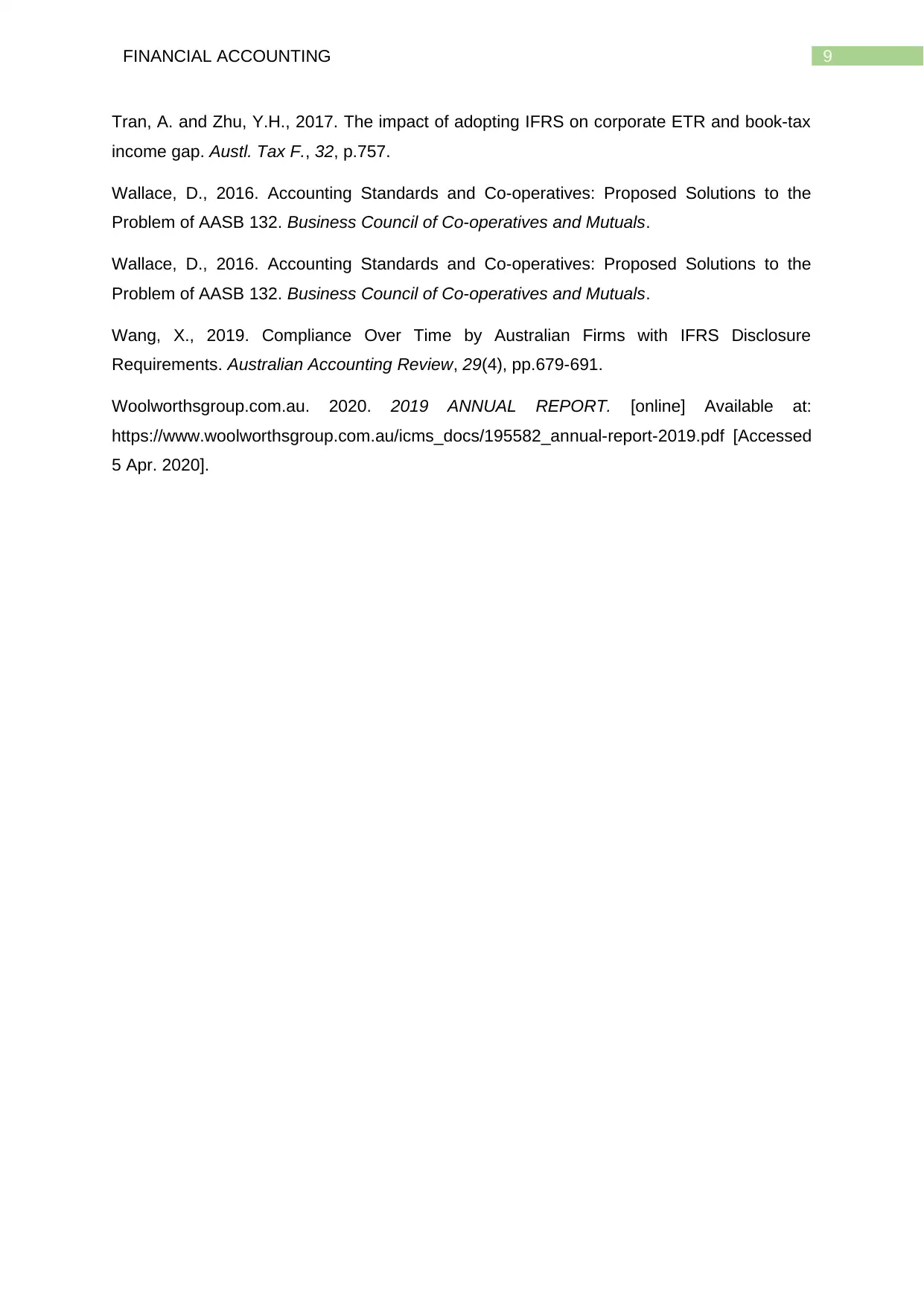
9FINANCIAL ACCOUNTING
Tran, A. and Zhu, Y.H., 2017. The impact of adopting IFRS on corporate ETR and book-tax
income gap. Austl. Tax F., 32, p.757.
Wallace, D., 2016. Accounting Standards and Co-operatives: Proposed Solutions to the
Problem of AASB 132. Business Council of Co-operatives and Mutuals.
Wallace, D., 2016. Accounting Standards and Co-operatives: Proposed Solutions to the
Problem of AASB 132. Business Council of Co-operatives and Mutuals.
Wang, X., 2019. Compliance Over Time by Australian Firms with IFRS Disclosure
Requirements. Australian Accounting Review, 29(4), pp.679-691.
Woolworthsgroup.com.au. 2020. 2019 ANNUAL REPORT. [online] Available at:
https://www.woolworthsgroup.com.au/icms_docs/195582_annual-report-2019.pdf [Accessed
5 Apr. 2020].
Tran, A. and Zhu, Y.H., 2017. The impact of adopting IFRS on corporate ETR and book-tax
income gap. Austl. Tax F., 32, p.757.
Wallace, D., 2016. Accounting Standards and Co-operatives: Proposed Solutions to the
Problem of AASB 132. Business Council of Co-operatives and Mutuals.
Wallace, D., 2016. Accounting Standards and Co-operatives: Proposed Solutions to the
Problem of AASB 132. Business Council of Co-operatives and Mutuals.
Wang, X., 2019. Compliance Over Time by Australian Firms with IFRS Disclosure
Requirements. Australian Accounting Review, 29(4), pp.679-691.
Woolworthsgroup.com.au. 2020. 2019 ANNUAL REPORT. [online] Available at:
https://www.woolworthsgroup.com.au/icms_docs/195582_annual-report-2019.pdf [Accessed
5 Apr. 2020].
1 out of 10
Related Documents
Your All-in-One AI-Powered Toolkit for Academic Success.
+13062052269
info@desklib.com
Available 24*7 on WhatsApp / Email
![[object Object]](/_next/static/media/star-bottom.7253800d.svg)
Unlock your academic potential
© 2024 | Zucol Services PVT LTD | All rights reserved.





